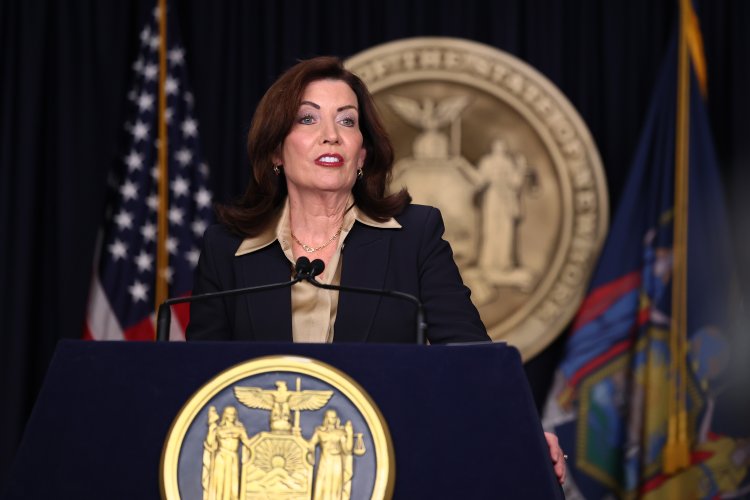New York progresses toward implementing a statewide ban on cellphones in schools
The governor and lawmakers are approaching a consensus on implementing a comprehensive all-day ban referred to as “bell to bell.”

Gov. Hochul and state lawmakers are working on finalizing the details of a comprehensive “bell-to-bell” restriction, which has emerged as a prominent issue during her administration. Legislative leaders have endorsed this complex proposal and are currently awaiting the policy language while they navigate the state's $252 billion budget deadline, which is set for Monday.
Although a resolution is still pending, the governor seems close to securing this policy win.
Hochul has managed to overcome initial hesitations from Assembly Speaker Carl Heastie and Senate Majority Leader Andrea Stewart-Cousins, which positions New York to become the fifth state nationally to enact a ban on cellphone use in schools, following Arkansas, Louisiana, Virginia, and South Carolina. Numerous other states, both Democrat and Republican-led, have already established phone bans or restrictions. Florida, the pioneer in limiting cellphone use during class, is also considering a similar all-day approach.
“No smart phones, no ear buds, no cell phones, and here's why: The mental health of our children, especially middle school and high school, is really declining,” Hochul stated in a recent interview with Telemundo 47.
This initiative aligns with Hochul's priorities as she prepares for a potentially competitive reelection campaign next year. She first expressed her commitment to curbing smartphone usage last spring as part of a broader child safety initiative. In June, she enacted legislation to limit social media algorithms for children. The “bell-to-bell” concept was introduced during her budget address in January and has since become a core focus of her agenda, as she frequently discusses the adverse effects of phone usage on students. Public sentiment appears to support this move, with a recent Siena poll indicating that 62 percent of voters favor banning smartphones during school hours.
Hochul quickly garnered support from New York’s influential teachers' unions, although she faced pushback from the state’s school boards and superintendents, who contend that districts should have the autonomy to establish their own cellphone policies.
“All the parties are talking and I’m very hopeful there’ll be a resolution that recognizes the dangers of electronic devices and also recognizes some schools have adopted thoughtful policies,” remarked Senate Education Committee Chair Shelley Mayer.
Mayer was among 12 lawmakers in Albany, both staunch proponents and those who have recently come to support the ban, who expressed optimism about reaching a consensus.
Unusually, Hochul found bipartisan agreement among elected officials on this issue, even as they remain deadlocked on other contentious matters, including proposals to simplify evidence requirements for prosecutors.
“I truly think this in New York will become a national model,” asserted Raj Goyle from the group Phone Free New York, who noted that their research "really revealed what a patchwork of restrictions there are now." The organization has received significant funding from unnamed philanthropists, according to Goyle, a former Kansas lawmaker residing in Manhattan.
An anonymous state official shared that resolving the outstanding disagreements surrounding the cellphone issue would likely be “the easiest to put to bed.”
“Getting people to side with bell-to-bell is easier than getting people to side with ‘Well what about this exception, this exception,’” the official explained. “It’s easier to sell to your constituents to be like, ‘Look, there’s one policy in place, everyone abides by it.’”
Despite initial challenges in her efforts to implement a ban, which included a $13.5 million allocation, Hochul has made progress.
In response to her budget proposal, the Senate suggested allowing districts to permit cellphone use during non-instructional times, such as lunch, reiterating that students could not face suspension solely for phone use.
The Assembly's response did not include Hochul’s proposal but allocated $38.5 million to schools. Heastie indicated that while his members supported the overall concept, there was division regarding whether it should be pursued statewide. However, they have since shown greater support for the governor's initiative, with Heastie and Stewart-Cousins indicating last week that their conferences were leaning towards endorsing the bell-to-bell approach.
State Sen. John Liu, chair of the education committee, defended the Senate’s initial proposal amid criticism, stating that some districts had already implemented their own policies and were hesitant to change course. He indicated those concerns have since been addressed.
Hochul’s plan allows exceptions for students who require devices for medical reasons, English language learners, and those with disabilities. She also assured that the state would not suspend students for smartphone misuse.
Furthermore, districts must establish at least one means for parents to contact their children throughout the school day.
Melinda Person, president of New York State United Teachers, shared that she successfully won over legislators by emphasizing how non-classroom time contributes to the development of student social skills.
“There were some tweaks specifically in the Senate bill related to school suspensions and cellphones,” Person noted. “That’s a tweak that we think makes a lot of sense. There may be some tweaks, but our hope is that the core concept of bell-to-bell remains in the final bill.”
While the path toward a statewide mandate appears to be nearly complete, opposition persists.
Organizations representing school boards and superintendents prefer the original Senate approach, which would grant districts the authority to determine cellphone use during non-instructional times. They also backed legislation from Assembly Standing Committee on Education Chair Michael Benedetto that would require districts to develop policies with stakeholder input, including from parents.
Benedetto expressed confidence that Heastie would reach “a fair decision.”
“I happen to think my bill and the way I look at it to be the best possible way,” he stated. “But I also acknowledge that maybe I’m wrong and maybe wiser minds will come up with a better idea.”
Allen M Lee for TROIB News












